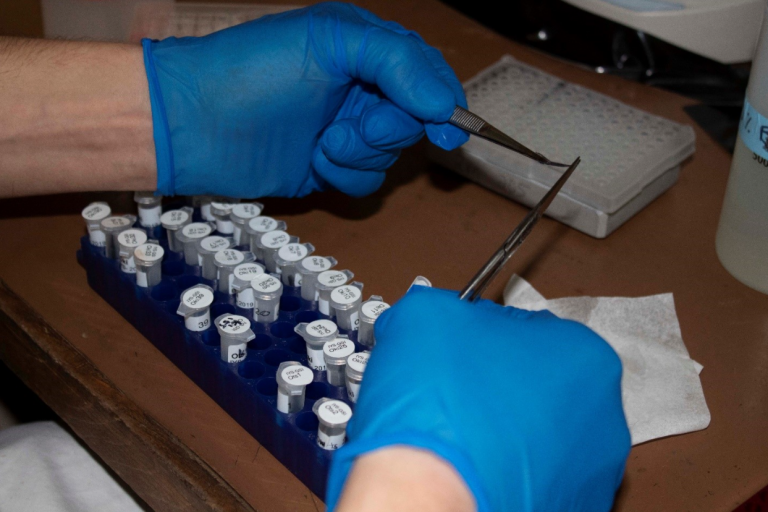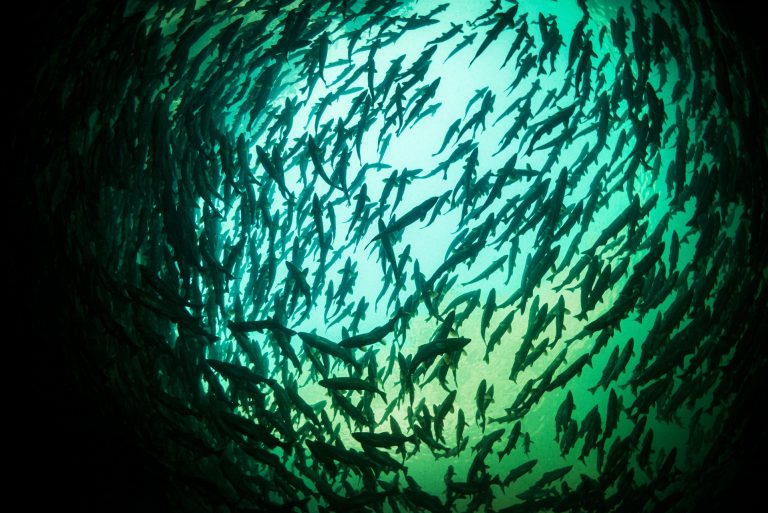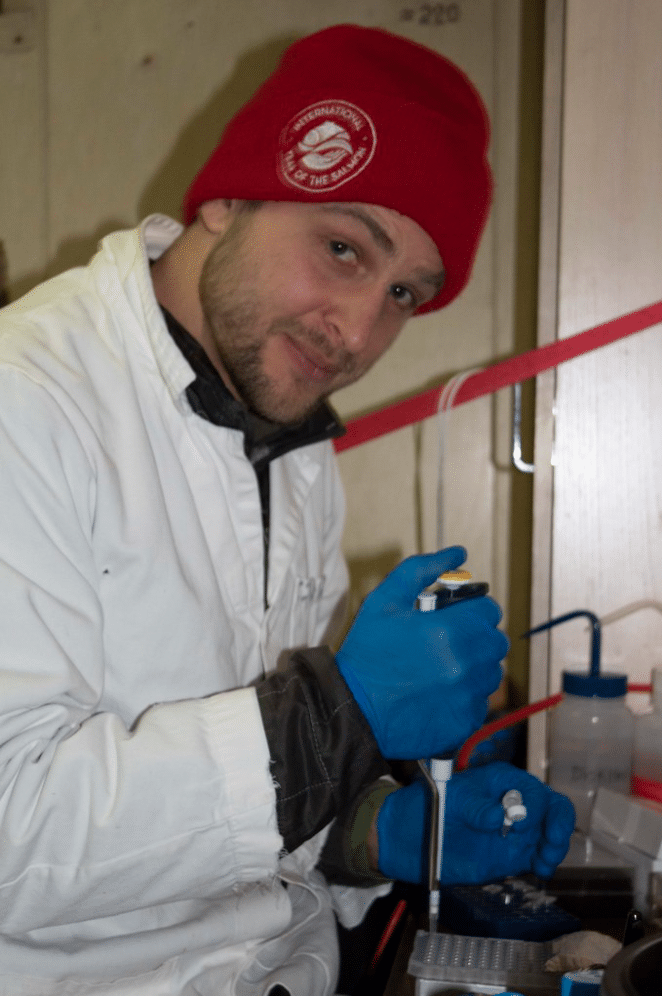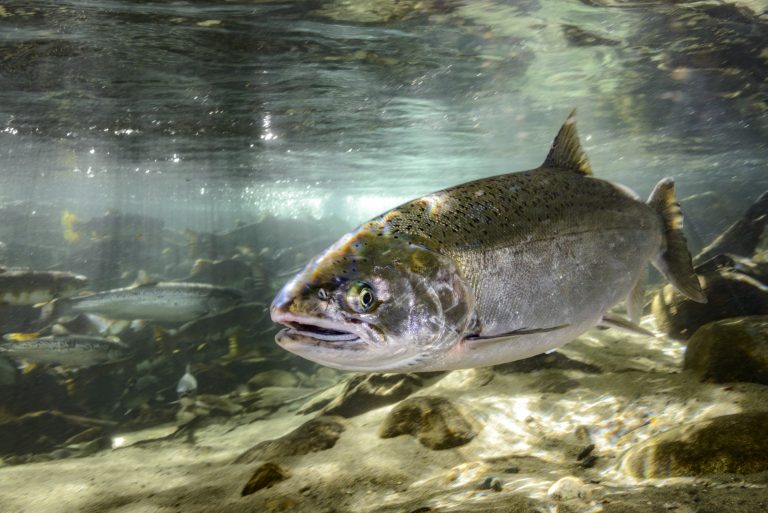SNP-its of Genes Determine Origins of Pacific Salmon at Sea
Andrew Chin, NPAFC Intern
July 1, 2021
It was another long-haul day for Dr. Christoph Deeg. As he braced himself in the bowels of a research vessel against the winter waves of the Gulf of Alaska, he was carefully extracting DNA samples from the fin clips of freshly caught Pacific salmon. “Probably 90% of my time was spent down there,” Christoph said, saying he watched a pendulum pinned to the wall which swung back and forth with the ship’s heaving. Those long hours, however, are paying off, as Christoph and his collaborators have since been uncovering the ecology and distribution that remain a critical gap for sustainable salmon management.
Scientists from the five member countries of the North Pacific Anadromous Fish Commission (NPAFC) — Canada, Japan, Korea, Russia, and the United States — conducted two surveys in the winters of 2019 and 2020 in the Gulf of Alaska. Dubbed the International Year of the Salmon (IYS) Winter Gulf of Alaska Expeditions, the goals were to better understand the winter ecology of Pacific salmon in the North Pacific Ocean and the effects of rapid climate change on salmon populations around the North Pacific Rim. Many of the insights that the expedition hoped to gain, such as the distribution of salmon and their rivers of origin, can best be revealed by asking the salmon themselves, through their DNA.

Just like humans, the genetic code of salmon is made up of four base compounds, shortened to single letters (A, C, T, and G). Unique combinations of this code are what make up DNA. Small differences in this code between individuals and populations are the focus of geneticists and salmon scientists who aim to better understand salmon migratory routes and better predict salmon returns across the Northern Hemisphere.
Population geneticists initially identified small repetitive regions in the genome, called microsatellites, to differentiate fish populations. However, recent advances in technology have enabled the targetting of the smallest changes in a fish’s genetic alphabet soup, identifying where an A may have swapped for T, or a T for a G, etc. These small swaps are called single nucleotide polymorphisms (SNPs, pronouced “Snips”). If a fish is found with a certain number of SNPs in different parts of their genetic code, we can know which specific geographic region the fish came from, or even the specific river, provided there are reference samples from these regions to compare to. A comprehensive reference library of genetic baselines across a salmon’s range is critical for identification. This genetic stock identification (GSI) technique is considered the gold standard for stock identification, and can determine what region of the North Pacific Rim each salmon caught in the ocean originated from.
This genetic technique works because of salmon’s innate instinct to return and spawn in their natal stream so that over time, a population’s genetic pool becomes distinct. When salmon enter the borderless ocean, they freely intermingle with other salmon, even from different continents, following prey or ocean currents. However, they still retain genetic differences from their population, and these differences can then be identified by modern genetic tools.

Gaining an understanding of population-specific distributions is a key step for a more holistic understanding of Pacific salmon ecology. Abundant salmon populations are found alongside populations threatened by habitat loss, fishing pressure, or climate change in the North Pacific. Identifying stock origins is the first step in understanding the specific challenges that salmon face during their life cycle, and making management and habitat restoration decisions that have the most impact. In addition, rapid stock identification can help salmon fisheries become more adaptive to changes in salmon run timing or abundance.
Near-real time GSI is done for sockeye salmon test fisheries in Bristol Bay, Alaska in the US and Johnstone Strait in Canada. Sampling fish fin clips and analyzing the stock composition as they near their natal river mouth allows managers to determine whether to close or open the districts for fishing throughout the season. However, this test fishery is not able to analyze samples where fish are caught, requiring significant effort to send samples back to the laboratory by either boat or plane. Once DNA samples are extracted from fin clips in the lab, it can take several days for the current “second-generation” GSI machines, about the size of a large office printer, to prepare the reference library, read it into the computer (“sequencing”) and analyze the genetic code. By the time the results are reported several days later, it is already old news. In addition, the current second-generation GSI machines, that can handle thousands of samples, do not analyze the small, widely variable samples that test fisheries and fieldwork provide.

Christoph and Dr. Kristi Miller, Head of Salmon Genetics at Fisheries and Oceans Canada, saw the power of bringing this GSI technology to sea, not only for management but also for active research. “You can really target your research while you’re out in the field. Say you caught a bunch of Fraser River sockeye in a particular area. With real time GSI, we can identify those fish right away, then go back and resample without waiting to come back to the lab, ” Christoph says. However, bringing “the lab to the samples,” as he puts it, was an immense challenge, given the unstable nature of a ship at sea and without the extensive infrastructure that traditional GSI requires.
Christoph’s secret weapon was a nanopore Oxford minION sequencer. About the size and weight of a cell phone, the minION sequencer reads the extracted DNA into Christoph’s laptop where it can be analyzed. This process can help researchers determine where a fish originated from before stepping off the vessel, compared to waiting for processing in a lab or the costly business of flying samples from the fish back to the lab. Christoph, Kristi, and other collaborators have streamlined the process, so that the time between the fish hitting the deck and its origin being determined is just 36 hours. Examining coho salmon caught during the 2019 expeditions, Christoph was able to identify that the fish caught during the IYS Winter Gulf of Alaska Expeditions originated from Canada, Washington State, and Alaska.

At-sea GSI is not perfect. Often, opportunities to sit down and process the samples arose only during weather/ocean conditions that were too rough to fish in, making it difficult to conduct extremely precise DNA extraction. In comparison to a traditional laboratory system, Christoph, Kristi, and other collaborators found that at-sea stock assignment matched the stock identified by the state-of-the-art in-lab sequencers 61.5% of the time (this research is currently in pre-print). However, Christoph notes that both platforms were hampered by the limited genetic baseline for coho salmon that was used during the expedition. Armed with a new genetic baseline for coho populations and two cruises’ worth of experience, along with projects on salmon genomic health assessments and environmental DNA left behind by salmon and their predators in the water column, Christoph is excited for the upcoming IYS expedition. “I’ve got a thousand other things to work on,” he grinned.

